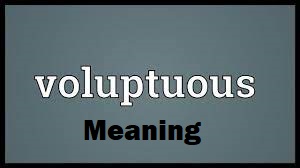Language is a living, breathing entity that evolves with society, culture, and context. Among the many words that carry both beauty and complexity, “voluptuous” stands as a particularly fascinating example. This adjective has traveled through centuries, carrying with it layers of meaning that span from artistic appreciation to physical description, from luxury to sensuality.
In our modern world of professional communication and cultural sensitivity, understanding not just what words mean but how they’re perceived has become crucial. Whether you’re a writer crafting the perfect description, a fashion industry professional seeking appropriate terminology, or simply someone who wants to communicate with elegance and respect, knowing when and how to use “voluptuous” – and when to choose alternatives – is invaluable.
This comprehensive guide will explore the etymology, nuances, and context of “voluptuous” while providing you with 11 polite alternatives that can enhance your vocabulary and ensure your language choices are always appropriate for your audience and setting.
What Does “Voluptuous” Mean?
The word “voluptuous” carries multiple layers of meaning that have developed over centuries of usage. At its core, this adjective describes something characterized by luxury, sensuality, and indulgence. However, the semantics of this word extend far beyond a simple denotation.
In contemporary usage, “voluptuous” most commonly describes a full-figured body type, particularly when referring to women. The word suggests curves, fullness, and a shapely silhouette that embodies feminine form. However, this physical description aspect is just one facet of its broader meaning.
The connotation of “voluptuous” also encompasses richness, luxury, and sensuous pleasure. When describing fabrics, environments, or experiences, it suggests something lush, opulent, and deeply satisfying to the senses. Think of voluptuous textures in luxury lifestyle settings or the luxurious experience of sinking into velvet cushions.
Dictionary Definition:
According to major dictionaries, “voluptuous” is defined as:
- Relating to or characterized by luxury or sensual pleasure: This denotation encompasses the word’s connection to hedonism and gratification
- Having a large, soft, rounded body shape: This meaning focuses on body shape and physical appearance
- Giving or suggesting sensual pleasure: This definition emphasizes the aesthetic pleasure and sensory gratification aspects
The linguistic context of these definitions shows how the word operates across different semantic fields, from luxury/indulgence to physical description to art/aesthetics.
Example Sentences:
To better understand the word usage and tone of “voluptuous”, consider these examples:
- “The voluptuous curves of the sculpture captured the artist’s vision of classical beauty.”
- “She decorated her hotel suite with voluptuous textures and rich fabrics.”
- “The voluptuous beauty of the garden was enhanced by lush plantings and abundant blooms.”
- “The actress was known for her voluptuous figure and commanding screen presence.”
Each example demonstrates different aspects of the word’s semantic analysis and shows how context determines its specific meaning and appropriateness.
Etymology: Where Did the Word Come From?
Understanding the etymology of “voluptuous” provides crucial insight into its linguistic history and word development. The term derives from the Latin word “voluptas,” which means pleasure or delight. This classical language origin reveals the word origin in concepts of enjoyment and sensory description.
The Latin etymology shows us that “voluptuous” entered English through French in the 17th century, during a period when many luxury terms and aesthetic vocabulary were being borrowed from Romance languages. The morphological elements include the root “voluptas” combined with the suffix “-ous,” which forms adjectives meaning “characterized by” or “full of.”
This historical usage demonstrates how the word originally encompassed broader concepts of pleasure and indulgence before becoming more specifically associated with physical description in modern times. The language evolution reflects changing social attitudes toward body image, sensuality, and appropriate descriptive writing.
Nuances and Tone: Why “Voluptuous” Can Be Tricky
The complexity of “voluptuous” lies not in its denotation but in its connotation and the social context in which it’s used. While the word can be used appreciatively and respectfully, it carries certain nuances that make it potentially problematic in many situations.
The primary concern with “voluptuous” is its potential for objectifying language. When used to describe people, particularly women, it can reduce them to their physical appearance rather than acknowledging their full humanity. This social perception has led many to seek professional alternatives that maintain respect while still allowing for aesthetic terms.
The tone of “voluptuous” also varies significantly depending on register variations. In casual conversation, it might be received differently than in professional settings or artistic/creative contexts. The word carries sensual language undertones that may not be appropriate for workplace discussions or business language.
Additionally, the cultural sensitivity around body description words has evolved significantly. What was once considered a compliment might now be perceived as inappropriate or objectifying, particularly in professional communication or formal communication settings.
Things to Consider Before Using It:
Before using “voluptuous” in any context, consider these important factors:
Audience and Setting: Is this a professional environment, casual setting, or artistic context? The appropriateness varies dramatically.
Relationship: Your relationship with the person being described matters significantly. Intimate description language that’s appropriate between partners may be entirely inappropriate in other relationships.
Intent: Are you trying to compliment someone, provide descriptive writing, or engage in literary language? Your intent should guide your word selection.
Cultural Context: Consider the cultural nuances and social appropriateness of your language choice within your specific community and setting.
Potential Impact: How might your word choice affect the person being described or your audience? Respectful communication should always be the priority.
11 Polite, Professional, and Casual Alternatives to “Voluptuous”
Finding the right alternative to “voluptuous” depends on your specific needs, context, and audience. Here are 11 sophisticated options that can help you communicate with elegance, respect, and precision.
1. Curvaceous
“Curvaceous” is perhaps the most direct synonym for the physical description aspect of “voluptuous.” This adjective specifically emphasizes body shape and curves without carrying the same sensual undertones.
Why it works: “Curvaceous” focuses on geometric aspects of form and silhouette, making it more neutral and appropriate for professional contexts. It’s commonly used in fashion terminology and modeling terms without the objectifying concerns of “voluptuous.”
Best contexts: Fashion writing, professional descriptions, aesthetic terms in art, and situations where you want to acknowledge physical appearance respectfully.
Example: “The designer created a dress that flattered curvaceous figures with its well-proportioned cut.”
2. Well-Proportioned
This alternative shifts focus from sensuality to balance and harmony. “Well-proportioned” suggests aesthetic pleasure derived from proportions rather than from sensuous appeal.
Why it works: The term emphasizes artistic beauty and mathematical harmony, making it suitable for professional and artistic contexts. It’s respectful while still acknowledging physical attributes.
Best contexts: Art criticism, architectural descriptions, professional settings, and any situation requiring diplomatic language.
Example: “The sculpture featured a well-proportioned figure that exemplified classical beauty standards.”
3. Full-Figured
“Full-figured” is a respectful and straightforward alternative that acknowledges body type without objectifying language. It’s widely accepted in fashion industry and professional contexts.
Why it works: This term is body positive and empowering, focusing on confidence and self-acceptance rather than sexualization. It’s commonly used in fashion industry professional terminology.
Best contexts: Fashion descriptions, professional conversations, body positivity discussions, and retail environments.
Example: “The brand’s new line celebrates full-figured women with stylish and sophisticated designs.”
4. Shapely
“Shapely” emphasizes attractive form and pleasing proportions while maintaining a polite and appropriate tone. It’s versatile enough for various contexts.
Why it works: The word focuses on aesthetic appeal and visual attractiveness without sensual implications. It’s refined and sophisticated while remaining accessible.
Best contexts: General compliments, artistic descriptions, fashion contexts, and casual conversations where appropriateness is important.
Example: “The dancer’s shapely movements captured the audience’s attention throughout the performance.”
5. Lush
Moving beyond physical description, “lush” captures the luxury and richness aspects of “voluptuous” without the physical connotations.
Why it works: “Lush” emphasizes abundance, richness, and luxurious texture while being appropriate for describing environments, experiences, and aesthetic qualities.
Best contexts: Luxury lifestyle descriptions, travel writing, interior design, garden descriptions, and artistic contexts.
Example: “The lush fabrics and rich colors created a luxurious atmosphere in the hotel suite.”
6. Sensual
While “sensual” shares some connotations with “voluptuous,” it’s often more appropriate because it can describe experiences, environments, and aesthetic qualities rather than focusing primarily on physical appearance.
Why it works: “Sensual” emphasizes sensory experience and aesthetic pleasure while being versatile enough for artistic, culinary, and environmental descriptions.
Best contexts: Art criticism, culinary descriptions, luxury brand communication, romantic language, and creative writing.
Example: “The sensual textures and warm lighting created an inviting ambiance.”
7. Elegant
“Elegant” shifts focus entirely to sophistication, grace, and refined beauty. It’s universally appropriate and positive.
Why it works: This alternative emphasizes style, sophistication, and refined aesthetic appeal while being appropriate for any professional or social context.
Best contexts: Professional compliments, formal occasions, business writing, fashion industry, and any situation requiring diplomatic language.
Example: “Her elegant posture and graceful movements made her a natural choice for the runway.”
8. Opulent
“Opulent” captures the luxury and richness aspects of “voluptuous” while focusing on material wealth and luxurious experiences.
Why it works: The word emphasizes luxury, abundance, and high-end terminology without personal physical connotations, making it appropriate for business and luxury brand contexts.
Best contexts: Luxury marketing, high-end retail, interior design, hospitality, and lifestyle vocabulary.
Example: “The opulent surroundings and luxurious amenities exceeded all expectations.”
9. Alluring
“Alluring” suggests attractiveness and appeal while maintaining sophistication and appropriateness. It can describe people, places, or experiences.
Why it works: This alternative emphasizes attractiveness and charm without objectifying language, making it suitable for professional and artistic contexts.
Best contexts: Marketing language, travel descriptions, artistic terminology, professional compliments, and creative expression.
Example: “The alluring combination of classical architecture and modern amenities attracts visitors from around the world.”
10. Buoyant
“Buoyant” emphasizes energy, liveliness, and positive spirit rather than physical attributes. It’s particularly appropriate for describing personality and demeanor.
Why it works: This word focuses on psychological and emotional qualities, making it appropriate for professional settings and personal compliments that emphasize character over appearance.
Best contexts: Professional evaluations, personality descriptions, motivational language, and positive character assessments.
Example: “Her buoyant personality and infectious enthusiasm made her an excellent team leader.”
11. Radiant
“Radiant” emphasizes inner beauty, confidence, and positive energy. It’s universally appropriate and uplifting.
Why it works: This alternative focuses on inner qualities and positive energy rather than physical attributes, making it perfect for respectful compliments and professional language.
Best contexts: Personal compliments, professional recognition, celebratory language, and any situation where you want to acknowledge someone’s positive presence.
Example: “Her radiant confidence and professional expertise made her presentation truly memorable.”
When and How to Choose the Right Word
Selecting the appropriate alternative to “voluptuous” requires careful consideration of multiple factors. The context, audience, relationship, and intent all play crucial roles in determining the most suitable word choice.
Professional Settings: In workplace environments, business communication, or corporate language, prioritize alternatives like “elegant,” “well-proportioned,” “professional,” or “sophisticated.” These choices maintain respect while avoiding potentially inappropriate connotations.
Casual Conversations: For informal interactions and social contexts, alternatives like “curvaceous,” “shapely,” or “attractive” can be appropriate depending on your relationship with the person and the social appropriateness of the conversation.
Artistic and Creative Contexts: In artistic terminology, creative writing, or aesthetic discussions, you have more flexibility with alternatives like “sensual,” “lush,” “alluring,” or “opulent.” These contexts often allow for more expressive language and sophisticated vocabulary.
Fashion and Beauty Industry: Professional fashion terminology and beauty industry language often use alternatives like “full-figured,” “curvaceous,” or “well-proportioned” as standard industry vocabulary.
The key is matching your word selection to your audience’s expectations and the formality of the situation. Consider both the literal meaning and the emotional impact of your choice.
Politeness in Language: A Subtle Superpower
Polite language and tactful expression represent more than mere social etiquette – they demonstrate emotional intelligence, cultural awareness, and respect for others. In our increasingly connected world, the ability to communicate appropriately across different contexts has become a valuable skill.
Language courtesy involves understanding not just what words mean, but how they’re perceived by different audiences. Respectful communication requires sensitivity to cultural nuances, generational differences, and individual preferences.
The evolution of language around body description reflects broader social changes in attitudes toward gender, body image, and personal dignity. Words that were once considered complimentary may now be perceived as objectifying or inappropriate.
Considerate speech and diplomatic language demonstrate professionalism and emotional maturity. They help build trust, maintain relationships, and create positive interactions across diverse contexts.
How the Meaning of “Voluptuous” Has Evolved Over Time
The semantic evolution of “voluptuous” reflects broader cultural shifts in attitudes toward sexuality, body image, and appropriate language. Understanding this historical context helps explain why the word can be problematic in modern usage.
In its original Latin form, “voluptas” simply meant pleasure or delight without specific sexual connotations. The word was used to describe various forms of sensory pleasure and aesthetic enjoyment.
During the 17th and 18th centuries, as the word entered English, it retained its broader meaning of luxury and sensual pleasure. Literature from this period uses “voluptuous” to describe rich fabrics, luxurious environments, and aesthetic experiences.
The 19th century saw the word beginning to focus more specifically on physical description, particularly of women. This shift coincided with changing social attitudes and the rise of certain beauty standards.
In contemporary usage, “voluptuous” has become increasingly associated with physical appearance and has acquired connotations that make it potentially problematic in many contexts. This evolution demonstrates how words can change meaning and appropriateness over time.
Real-Life Scenarios: Which Word Would You Use?
Understanding theoretical alternatives is valuable, but applying them in real situations requires practical judgment. Let’s explore specific scenarios where choosing the right alternative to “voluptuous” matters.
You’re writing a fashion article.
In fashion writing and fashion journalism, precision and appropriateness are crucial. Your audience expects professional terminology that respects diversity while effectively communicating style concepts.
Recommended alternatives: “Curvaceous,” “full-figured,” “well-proportioned,” or “shapely” work best in fashion contexts. These terms are widely accepted in the fashion industry and communicate clearly without objectifying language.
Example: “This season’s collections celebrate curvaceous figures with tailored designs that emphasize natural proportions and elegant silhouettes.”
You’re complimenting a colleague in a professional setting.
Professional compliments require careful consideration of workplace appropriateness and professional boundaries. The focus should be on professional qualities rather than physical appearance.
Recommended alternatives: “Elegant,” “professional,” “sophisticated,” “confident,” or “radiant” emphasize positive qualities without inappropriate focus on physical attributes.
Example: “Your elegant presentation style and confident delivery made that client meeting very successful.”
You’re describing a piece of art.
Artistic contexts allow for more expressive language and aesthetic vocabulary. Art criticism and artistic description often require sophisticated terminology that captures aesthetic qualities.
Recommended alternatives: “Sensual,” “lush,” “opulent,” “alluring,” or “well-proportioned” work well in artistic contexts where aesthetic appreciation is appropriate.
Example: “The sculptor’s use of lush curves and sensual forms creates a powerful statement about classical beauty and modern interpretation.”
Conclusion
The journey through the meaning, nuances, and alternatives to “voluptuous” reveals the complexity and beauty of language itself. Words are not merely tools for communication – they are vessels that carry cultural values, historical context, and emotional weight.
Understanding when and how to use “voluptuous” – and when to choose alternatives – demonstrates linguistic sophistication and cultural awareness. The 11 alternatives presented in this guide offer a rich palette of options for different contexts, audiences, and intentions.
Language evolution continues, and words that are appropriate today may need reconsideration tomorrow. The key is maintaining awareness of how our word choices affect others and adapting our vocabulary to promote respect, inclusion, and effective communication.
Whether you’re writing professionally, engaging in casual conversation, or creating artistic content, thoughtful word selection enhances your communication and demonstrates respect for your audience. The alternatives to “voluptuous” provide opportunities to express appreciation, beauty, and aesthetic pleasure while maintaining appropriateness and dignity.
Remember that effective communication is not about avoiding certain words entirely, but about choosing the right words for each specific context. Language is a powerful tool that can build bridges, create understanding, and foster positive relationships when used thoughtfully and respectfully.
Mastering these nuances of language – understanding etymology, recognizing connotations, and selecting appropriate alternatives – represents a subtle but significant form of communication expertise. In our interconnected world, this expertise serves as a foundation for meaningful, respectful, and effective human connection.

Catherine Frank, founder of BiblicalHorizon.com, shares daily prayers and Bible verses to nurture spiritual growth. With a lifelong passion for scripture and prayer traditions, she creates accessible spiritual content that resonates with both seasoned believers and newcomers seeking divine connection.



